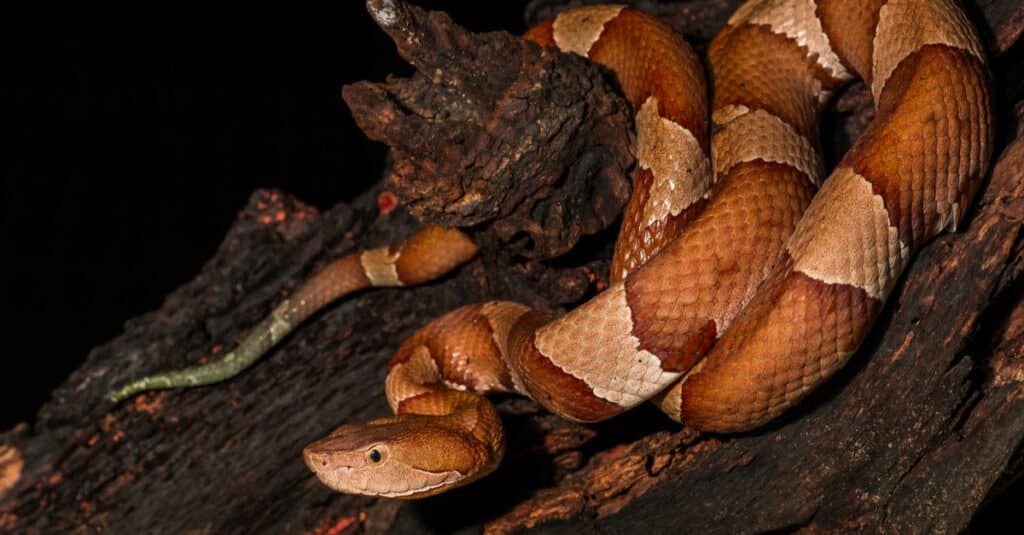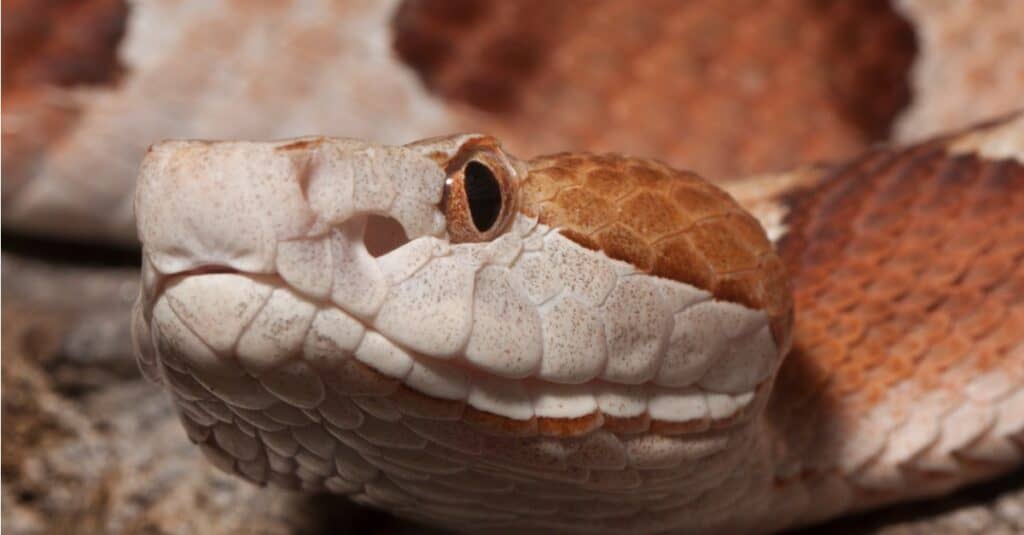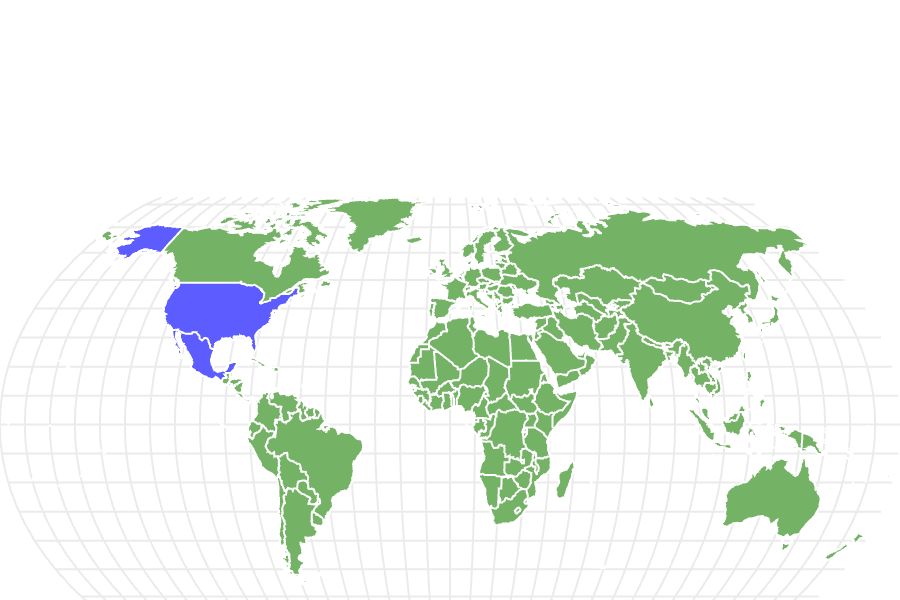Copperhead
.jumbotron {
background-image: url(“https://a-z-animals.com/media/2022/02/Copperhead-header-400×300.jpg”);
}
}
@media only screen and (min-width: 641px) and (max-width: 920px) {
.jumbotron {
background-image: url(“https://a-z-animals.com/media/2022/02/Copperhead-header-470×370.jpg”);
}
}
@media only screen and (min-width: 921px) {
.jumbotron {
background-image: url(“https://a-z-animals.com/media/2022/02/Copperhead-header.jpg”);
}
}
Copperhead
Agkistrodon contortrix
Copperheads get their name, unsurprisingly, from their bronze-hued heads.
Copperhead Facts
- Prey
- Insects, lizards, mice, voles, shrews, snakes, small turtles, salamanders, frogs, small birds, baby squirrels, rabbits and opossums, chipmunks, bats, moles, carrion
- Fun Fact
- Copperheads get their name, unsurprisingly, from their bronze-hued heads.
- Litter Size
- One to 21
- Diet
- Carnivore
- Common Name
- Copperhead, rattlesnake pilot, thunder snake, moccasin, highland or dry-land moccasin
This post may contain affiliate links to our partners like Chewy, Amazon, and others. Purchasing through these helps us further the A-Z Animals mission to educate about the world’s species..

Discover alligator-eating snakes, spiders larger than your phone, and 1000 more incredible animals in our daily FREE email.
.photo-gallery {
–margin: 0px auto 0px;
–padding: 0px 0px 0px 0px;
}
.gallery-link {
background-image: url(“https://a-z-animals.com/media/2022/02/Copperhead-header-1024×535.jpg”);
background-repeat: no-repeat;
background-size: cover;
background-position: center;
height: 500px;
justify-content: center;
text-align: center;
align-items: center;
display: flex;
border: 2px solid #000;
}
.gallery-link img {
height: 50%;
}
@media only screen and (max-width: 768px) {
.gallery-link {
height: 300px !important;
}
}
View all of the Copperhead images!
“The Copperhead is responsible for more snakebites than any other American snake.”
Agkistrodon contortrix is a retiring snake, but it still bites more people than any other snake in America. How is this? It’s because it is so well-camouflaged that it is easy for a person in bare feet or flip-flops to step on it inadvertently. Who wouldn’t bite if they were stepped on? Read on for some facts about this beautiful reptile.
Five Amazing Copperhead Facts
Here are five amazing facts about Agkistrodon contortrix.
button.pulse {
transform: scale(1); animation: pulse 2s infinite;
box-shadow: 0 0 0 0 rgba(11, 247, 25, 1);
}
@keyframes pulse {
0% { transform: scale(0.90); box-shadow: 0 0 0 0 rgba(11, 247, 25, 0.5); }
60% { transform: scale(1); box-shadow: 0 0 0 15px rgba(11, 247, 25, 0); }
100% { transform: scale(0.90); box-shadow: 0 0 0 0 rgba(11, 247, 25, 0); }
}
- It has been known to give birth without the help of a male. This is called parthenogenesis.
- Young A. contortrix wiggle the tips of their tails to attract prey such as frogs or lizards. The tail mimics a worm.
- “Copperhead” was the name given to northern Democrats who were against the American Civil War.
- They hibernate and have been seen hibernating in locations with other snakes such as rattlers and rat snakes.
- Kingsnakes and opossums seem to be immune to the venom of the copperhead.
Where To Find the Copperhead
A. contortrix is native to the United States. It is found in southern Massachusetts, south to Georgia, west to Texas and northern Mexico, and as far north as Illinois and Ohio. Its wide geographic range has caused the snake to adapt to a variety of habitats such as open woods, oases, and edges of wetlands. Other habitats are areas near rivers and rocky outcrops. It also lives around human habitation, including construction sites. When it’s time to hibernate the snake prefers logs, stumps, crevices, caves, and the foundations of buildings that have a south or west exposure.
Copperhead Scientific Name
Agkistrodon contortrix can be interpreted as a “fishhook toothed snake with twisted bands down its back.” Agkistrodon comes from the Greek ancistro, which means “hooked” and odon, which means “tooth.” Contortrix comes from the Latin contortus, which can mean “twisted,” “complex” or “intricate” and refers to the beautiful hourglass patches on the snake’s back that help in its identification. There are four subspecies according to the Integrated Taxonomic Information System. They are:
- Agkistrodon contortrix contortrix
- Agkistrodon contortrix mokasen
- Agkistrodon contortrix phaeogaster
- Agkistrodon contortrix pictigaster
The Different Types of Copperhead
The four subspecies of A. contortrix cited by ITIS are similar in looks and size but differ in location. The southern copperhead, which is A. contortrix contortrix is found in eastern Texas and eastern Oklahoma and ranges north to Nebraska and east to Illinois, Ohio, Pennsylvania, New York, Connecticut, and Massachusetts. Despite its name of a southern copperhead, it’s actually not found in Georgia or Florida.
Agkistrodon contortrix mokasen is the eastern copperhead, and it is, ironically, found in the southern states and as far north as Massachusetts. It’s also found in the Appalachian Mountains. The Osage copperhead, Agkistrodon contortrix phaeogaster is found in Missouri, Kansas, and Nebraska. The Trans-Pecos copperhead, Agkistrodon contortrix pictigaster is found in western Texas and northern Mexico.
Copperhead Population & Conservation Status
A. contortrix is a common snake in its range, and its conservation status is least concern.
How To Identify Copperhead: Appearance and Description
The color patterns on this snake make identification easy. Its ground color is pale brown to pinkish-brown, and it has darker, hour-glass-shaped bands down its body. Though other snakes have similar colors, no other snake has a series of hourglass-shaped bands. Its head, whose color gives the snake its common name, is broad and wedge-shaped, and its neck is slender. It is not large in size. Its body ranges from 2 to usually less than 4 feet, but it is robust. The belly is pale and maybe mottled with gray, black, or brown.
The reptile’s scales are keeled, and their eyes have vertical pupils that make them resemble cat’s eyes. The irises of the eyes can be rufous, tan, or orange. Young copperheads are grayer, but the tips of their tails are vivid yellow or greenish-yellow. This helps the little snake attract would-be prey who mistake its tail for a worm.
Copperhead Pictures

Creeping Things/Shutterstock.com

Wildvet/Shutterstock.com

iStock.com/Mark Kostich
Copperhead Venom: How Dangerous Are They?
The venom of A. contortrix is a hemotoxin, which means it destroys red blood cells. Yet copperheads are not the most dangerous of the pit vipers for at least two reasons. The first is they are not very aggressive, and the second reason is their venom is not very strong. Scientists believe it would take about 100 milligrams of venom to kill a person and few people have died after being bitten by A. contortrix.
A. contortrix is also known for delivering dry bites as a warning. These bites have little or no venom. If venom is injected, the symptoms are excruciating pain, terrible nausea, swelling of the area, and tingling. Muscle and bone can be destroyed if the snake bit the person on their hand or foot.
Copperhead Behavior and Humans
These snakes are not aggressive and can be described as shy. During the spring and fall, they are active in the daytime, but when the weather gets hot they become nocturnal. If there are warm days in the winter, they might leave their hibernacula to bask in the sun. They can do this on the ground or on a fallen long but have been known to climb as high as 16 feet into a tree to catch the warmth of the sun.
Copperheads are unusual for vipers because they will freeze in place if they sense would-be predators approaching. Another snake would move away. Copperheads assume that lying among fallen leaves or in the red clay found in a state such as Georgia will camouflage them, which it usually does. They’ll also vibrate their tail if the predator is getting too close. The noise is meant to resemble the rattling of a rattlesnake.
These snakes usually lie in wait for prey to come within striking distance. They bite and envenomate their prey quickly. If it’s small, they’ll simply hold it in the mouth, but if it’s large, they’ll wait for it to die, find it, then swallow it whole. Born stealthy predators, juveniles stalk their prey more often than adults.
The breeding seasons for A. contortrix are February to May and then from August to October. Males look for mates by using their forked tongues to pick up the molecules of pheromones. Their tongues are longer than those of females and can be an aid in the identification of the sexes. Males sometimes fight over females. Not only that, after he’s conquered his rival he has to court the female, who may not even be interested, and try to fight him herself. If she is interested, she’ll raise her tail. Females can mate with many males, and babies in one litter can have different fathers. The female may not become gravid right away but can store sperm until after hibernation. The older and larger in size she is, the larger her babies. She’ll also have more of them.
A. contortrix females breed every one to three years and can have as many as 21 babies at a time, though the average is about six. Gestation is 83 to 150 days. These snakes do not make nests. Indeed, the only snake in the world that makes a proper nest is the king cobra. Instead of a nest, the copperhead gives birth in a location called a parturition site or a rookery.
After the mother snake gives birth, the babies stay with her for a few days then go off on their own. They are ready to breed themselves when they’re about 3.5 years old. A. contortrix has a long lifespan and can live as long as 29 years.
Though it’s true that A. contortrix is responsible for most snakebites in America, their bites are rarely fatal and are often dry. The snake is also helpful because it has vermin as part of its diet.
View all 157 animals that start with C
Copperhead FAQs (Frequently Asked Questions)
Are copperheads venomous?
They are venomous.
How do copperheads hunt?
As pit vipers and predators, they use heat-seeking pits to track their prey. They also pick up chemicals from their prey with their forked tongues. Usually, adults sit and wait for prey to come close, then strike, kill and swallow them.
Are copperheads aggressive?
These reptiles are not at all aggressive. They seem to bite only when they’re stepped on by accident or harassed.
Where do copperheads live?
They live in lower New England to Georgia and the Florida panhandle. They’re also found in Texas, north into Nebraska and Kansas, and northeast into Illinois. The Trans-Pecos copperhead is also found in northern Mexico.
What do copperheads eat?
A. contortrix is an opportunistic feeder and has a diet of any type of animal it can tackle. These include insects and non-insect invertebrates, birds, and small mammals. it will even eat carrion.
What is a copperhead?
It is a pit viper whose species name is Agkistrodon contortrix. It is known for its hourglass-shaped body bands and beautiful colors, including the reddish head that gives it its common name.
How poisonous is copperhead?
The snake is fairly poisonous, though deaths from its bite are rare.
Where do copperheads live?
They live in a variety of habitats that include woods, areas near rivers, wetlands, and even human habitations.
Are copperhead babies poisonous?
A. contortrix babies do indeed come equipped with fangs and their own venom.
What do you do if you get bit by a copperhead?
You need to seek medical attention immediately if you’ve been bitten by one of these pit vipers.
Do copperheads chase you?
They do not chase people.
How do I identify a copperhead snake?
Though it shares colors with other native snakes, identification of the copperhead can be had by the hourglass or saddlebag-shaped patches on its back.
Are copperheads born live or hatched?
These snakes give live birth.
How far can a copperhead strike?
Like most snakes, A. contortrix can strike between one-third and one-half the length of its body.
What’s the difference between a cottonmouth and a copperhead?
Copperheads give live birth, while cottonheads lay eggs. They also differ in their physical appearances. Read more of their differences here!
What’s the difference between a copperhead and a rattlesnake?
The main difference between a copperhead and a rattlesnake is the presence of a rattle. Rattlesnakes have a rattle and live in more locations compared to copperhead snakes.
What’s the difference between a black racer and a copperhead?
Black racers are longer than copperheads, but copperheads are far heavier. In terms of coloring, copperheads have a unique tan color with brown hourglass markings, while black racers are almost solid black. Black racers are non-venomous, but copperheads are pit vipers and come equipped with potent venom.
What are the differences between Copperhead and Kingsnake?
The main differences between copperheads and kingsnakes are that they belong to different families, inhabit slightly different ranges, and have unique physical characteristics. They differ in size, reproduce by different methods, kill unique prey by different means, and only one of them poses a threat to humans.
Who would win a fight between a black mamba and a copperhead?
A black mamba would win a fight against a copperhead. Black mambas have just about every important advantage over the diminutive copperhead. They’re larger, faster, have deadlier venom, and can attack from farther away.
What are the differences between garter snakes and copperheads?
The key differences between garter snakes and copperheads are their scientific families, slightly different ranges, size, eyes, markings, hunting methods, and venom potency.
What is the difference between a coachwhip and a copperhead?
A coachwhip differs from a copperhead in speed and length.
What’s the difference between a Texas rat snake and a copperhead?
The main differences between Texas rat snakes and copperheads are that they belong to different families, inhabit slightly different ranges, and have unique physical characteristics. They differ in size, reproduce by different methods, kill prey with different strategies, and only one of them poses a threat to humans.
Can cottonmouths breed with copperheads?
Because the two species are in the same genus (Agkistrodon), interbreeding is possible.
What is the difference between the Australian copperhead and the American copperhead?
The key differences between the Australian copperhead and the American copperhead lie in their size, habitat, fang type, and family.
What is the difference between a copperhead and a coral snake?
The main differences between a coral snake and a copperhead lie in their size, taxonomy, venom yield, fang type, and diet among others.
What is the difference between a copperhead and a northern watersnake?
The major difference between these two snake species is their venom- or the lack of it. American copperheads are venomous and although they aren’t regular killers, several people have been reported to have lost their lives from their bites. Northern watersnakes, on the other hand, are entirely nonvenomous and are less dangerous than copperheads to humans.
What is the difference between a copperhead and a pine snake?
The main difference between a copperhead and a pine snake is that copperheads are copper-colored, venomous, and live all over the eastern United States. Pine snakes are brown and white, aren’t venomous, and live only in the southeast.
What is the difference between copperhead and eastern fox snake?
The key difference between the copperhead and the eastern fox snake is that copperheads are venomous, while eastern fox snakes lack venom.
What are the differences between copperhead and eastern hognose snake?
The key differences between a copperhead and an eastern hognose snake include habitat, appearance, venom, snout, defensive behavior, and reproduction.
Sources
- Snakes For Pets, Available here: https://www.snakesforpets.com/how-far-away-can-a-snake-strike/
- Wikipedia, Available here: https://en.wikipedia.org/wiki/Eastern_copperhead
- ITIS, Available here: https://www.itis.gov/servlet/SingleRpt/SingleRpt?search_topic=TSN&search_value=174296#null
- National Geographic, Available here: https://www.nationalgeographic.com/animals/reptiles/facts/copperhead-snakes
- IUCN Red List, Available here: https://www.iucnredlist.org/search?query=Agkistrodon%20contortrix&searchType=species
- Live Science, Available here: https://www.livescience.com/43641-copperhead-snake.html
- Smithsonian’s National Zoo & Conservation Biology Institute, Available here: https://nationalzoo.si.edu/animals/northern-copperhead
- Medium, Available here: https://medium.com/natural-world/snake-nests-e74db9aac8d8
















